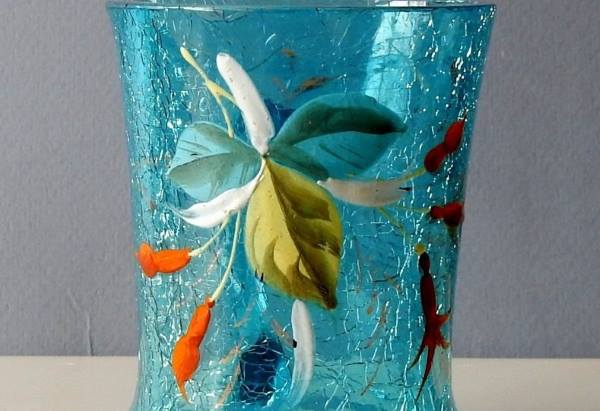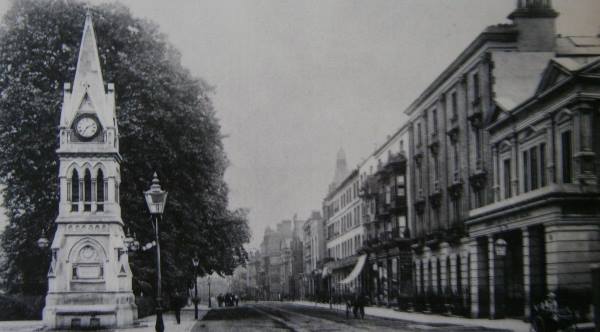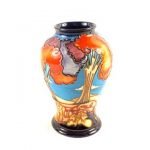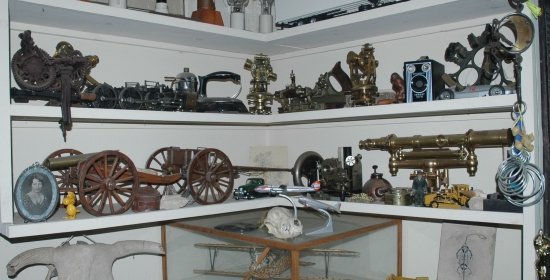Lustreware is usually thought of as being an innovation of certain English potteries in the 18th century and later, but in fact its history goes back much further. It is believed the process was first devised by the Persians in the 10th century A.D. and improved by the Moors in Spain. As early as 1350 A.D. beautiful lustre pottery, Hispano-Moresque, was being made in Spain, and it was a feature of Islamic pottery from around this time. From the early 16th century attractive red lustreware was being produced at Gubbio, Italy. Italian manuscripts exist stating the methods used for this lustreware. So it is more likely that English potters improved on what was already known, using the latest techniques and materials.
A John Hancock was employed by the Staffordshire, England, factory of Henry Daniel and John Brown, enamelers, of Hanley, in the late 18th century. When almost at the end of his career in 1846 Hancock published a letter in a Staffordshire newspaper claiming that only he and not others who had been named as “inventors” of lustreware, “discovered and put into practice the gold, silver, and steel lustre at Spodes factory at Stoke in 1789.” What is certain is that Hancock did not keep his formula secrets but sold them for quite small sums to any other potter who wanted them. Soon lustreware was being widely manufactured. For instance, Thomas Barlow at Longton Hall, Staffordshire, was one of the factories producing silver and copper lustreware soon after Hancockís letter.
Curiously no-one seems to have thought of obtaining a patent for lustreware until Peter Warburton of the New Hall Company at Shelton, Staffordshire, did so in 1810 for his “newly invented method of decorating china, porcelain, earthenware, and glass, with gold, silver, platinum, or other metals fluxed with lead, which invention leaves the metals, after being burnt, in their metallic state.”
Examples of this time until 1812 have the rare painted mark on them: “Warburton’s Patent.”
Josiah Wedgwood was also involved in the development of lustreware. Some authorities claim he was using gold lustre as early as 1776, but this date rather jumps the gun and the truth is that Wedgwood was interested in experimenting with gold to achieve a lustre effect. In 1776 he had derived a formula for this but it was not until about 1792 that he discovered a gold lustre that met his high standards. He used it with pearlware dessert services. He also made commercial use of silver, pink, and his “moonlight” lustre from 1805. From 1820 Wedgwood used lustre in combination with enameling on pearlware, chiefly on cups and saucers, cream jugs, sugar bowls, and other small items.
The popularity of lustreware encouraged potteries throughout Europe to produce it. Among the most beautiful is Bottger lustreware with a pale purplish mother-of-pearl lustre, that was first achieved by J. F. Bottger from gold at the Meissen Porcelain Factory and used there until the 1730s. In the 1850s the English company, Burgess, Dale & Goddard, had a thriving trade exporting English lustreware to the United States and Canada.
There were five types of lustreware. One has all the surfaces completely covered with plain silver or copper-colored lustre, being dipped in liquid lustre, to give the earthenware an appearance of being made of silver or gold. The second is relief lustre, with parts of the relief heightened with lustre. The third type uses plain bands of lustre with painted enamel or transfer-printed decoration. The fourth type features painted lustre patterns on a paler background. The fifth type is resist and stencilled lustre. The quality is variable in all cases: the silver may be a dull lead color or glossily lustrous; copper lustre varies from bright gold to bronze to dull brown.
The lustre color is achieved by the action of heat on a metallic glaze. The ware, usually made of coarse earthenware, was, after molding, turned or planed to achieve a fine, smooth surface. After the ware had been glazed and fired in the normal manner it was dipped in the metallic glaze. A film of this glaze was allowed to dry on the ware and then refiring took place in the kiln. The heat left a hard and fast deposit of metal on the surface. If the metallic glaze was applied thickly then the result was a brilliant lustre resembling the color of the metal used; if applied thinly, the lustre would be iridescent.
Platinum and copper oxides were used to create silver and gold lustre effects respectively. Copper sulphate was used for red to gold; gold chloride for a rich purple-red; silver nitrate for yellow; bismuth-sub-nitrate for a bright iridescence.
Not surprisingly, the intensity of the lustre was affected by the quality of the clay used for the ware and by the strengths of the solutions used. Some of the best silver lustreware has an almost black clay base, as this was discovered to give a superior silver lustre.
Resist lustreware was very popular in Europe between 1810 and 1840, none being known after the latter date. In this ware there is a white or colored decoration on a lustre background, the latter often silver. First a white or tinted glaze was applied to the clay ware. then fired. The design was painted with a gluey substance which would repel or resist the lustre coating but could be removed by water. The decorated ware was then dipped into the metallic solution to coat all the surface not protected by the resist substance. When almost dry it was washed in running water to remove the resist substance and then another firing completed the process.
Stencilled lustreware was achieved by applying a paper stencil design on to the glazed ware. The cut-out parts of the stencil were then washed over with a metallic lustre that rapidly dried so that when the paper stencil was removed the design was outlined against the paler background, the process being completed also with a firing. Both resist and stencilled types of lustreware were produced in the Yorkshire potteries, Leeds, Swinton, Castleford, and Don.
Splashed lustreware was made by splashing drops of oil on the lustre. A type known as pelure lustreware has a seemingly good surface until closely examined, when it will be seen to have an orange-peel texture ñ a pitted surface produced by manganese. Sporting lustreware is simply resist lustreware with a background scene of a rural activity such as hunting. Dragon lustreware, as might be guessed, is in a Chinese style with a decoration of scaled dragons chasing sacred pearls; it was devised at Wedgwood in 1914. Fairyland lustreware is also a Wedgwood development, having whimsical animals and such in a fairyland setting, the colors being iridescent.
Probably the best known lustreware is the variable pink Sunderland lustreware, made from around 1800 to the 1880s by several potteries in County Durham, north England. The earthenware used was a rather coarse cream color, either plain or black transfer-printed, some of the latter being colored by hand and in a frame of pink lustre. Sometimes the lustre is in irregular splashes or marbling. Although cruder than some types of lustreware, Sunderland lustreware has a charm which keeps it collectable.
Much of that produced was exported to North America and elsewhere from 1820 to 1860. The figures are of many types – pastoral subjects, religious subjects, topical people of the day, as well as animals. Plaques were also made, with a religious text, sentiment, or Biblical quotation, the lines being inside a lustre frame. Jugs were very commonly produced. So, too, were commode chamber pots, some also having rather erotic inscriptions.
One of the common transfer-prints on Sunderland lustreware shows the Wearmouth Bridge, Sunderland, which was opened in 1796. Thirty-three different transfer-print views of this bridge are known, mostly in black, but some are in green or blue, while others that are black are also hand-colored. One of the verses used on them commemorates a certain Jack Crawford who climbed a mast of his ship at the Battle of Camperdown in 1797 to nail a Union Jack to it: “At Camperdown we fought/And when at the worst of the fray/Our mizzen near the top boys/Was fairly shot away/The foe thought we had struck/ But Jack cried out “Avast”/And the colors of Old England/He nailed up to the mast.”
This type of speckled pink lustreware, however, was also made at Bristol, Liverpool, and in Staffordshire potteries. The snag regarding identification is that few of these examples are marked, but fortunately some of the true Sunderland wares are.
In the later 19th century lustreware went out of fashion but at the turn of the 20th century several potteries revived it for tiles and hollow-ware manufacture, especially as it was suitable for Art Nouveau. One of the most prominent British manufacturers now was Pilkington Tile and Pottery Company who began to produce ornamental ware with decorative lustre effects and motifs by artists and designers of the day from 1897 until 1938. This distinctive ware was known as “Royal Lancastrian,” early examples having a combined “P” and “L”‘mark, later examples the words “Royal Lancastrian” either side of a circular design like a rose with the combined “P” and “L” in its center.
Lustre decoration in the “Persian” colors of turquoise, blue, and green was used by William de Morgan, a designer and manufacturer of decorative earthenwares at Chelsea and Fulham from 1872 to 1907. These have several different marks incorporating De Morgan and ìMerton Abbey” or “Sands End,” or may have a tulip-like mark with “D.M.”
During the 1920s and 1930s lustreware continued to be produced as fine ware or as cheaply produced souvenirs, fairground prizes and such. It is still being made in some of the Staffordshire potteries in exactly the same way, and some examples are with the designs of the 18th and l9th centuries, using the same molds.
Not surprisingly many earlier examples have been faked; some of these were skillfully made and are, by now, difficult to identify from the real item. Price has to be a clue to authenticity with resist lustreware; for example, if it is cheap, it is a fake. Another clue is to know what a pottery was producing at the time the fake is to represent and judge whether the item looks that old. Modern fakers tend to apply the lustre too thickly; the copper is too brown and the silver too grey. Sometimes they even put the wrong lustre on an item which is supposed to be from a certain pottery or period, but the unsuspecting may not realize that until too late. Fakers also tend to make fakes too heavy; old examples are light for their size. Sunderland lustreware is probably the most frequently faked.
Modern fakes are also betrayed by having an unnatural whiteness to the background which will turn to brownish quite quickly when exposed to strong light. Put the item in a window in the sun and you will soon know whether it is genuine or not. The glaze should have an amount of “crackle” caused during its lifetime, but fakers seem to be unable to control this and tend to create too much “crackle” than there would be naturally. Look closely at the colors, of the backgrounds, which in a fake may have a dirty unreal hue caused by the “blacking” used to make them look “antique.”





